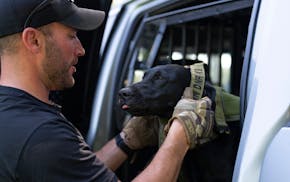Now's the time of year people might glimpse an opossum along roadsides, scurrying past campsites or through backyards searching for food and possibly carrying a young brood of babies.
These white-faced, pink-nosed, rat-tailed creatures are North America's only marsupial. They're related to kangaroos and other animals that carry their babies in a pouch on their stomach. They also share the term "joeys" for the babies.
Technically called Virginia opossums, they mate between January and May and can have litters of six to 20 babies about two weeks later.
Babies are born tiny, undeveloped and hairless. They weigh less than a penny and are about the size of a bumblebee. They're able to instinctively crawl into the mother's pouch where they find warmth and teats to latch onto. They live there for about two months, until they're fully developed.
When they're about the size of a mouse, the babies emerge from the pouch and ride on the mother's back until they've grown more independent. They can be found in the southern two-thirds of the state, often nesting in hollow logs, under buildings such as sheds or porches, and in brush piles and dens in the ground.
Opossums tend to be solitary and transient, always on the move at night for food. They will eat grasses, leaves, worms, slugs, snails, insects (including ticks), eggs, young birds, overripe fruits, grain, garbage and dead animals. Afterward, they meticulously wash themselves like cats with their paws. They aren't picky and can even eat venomous snakes.
They try to avoid predators such as dogs, bobcats, coyotes, foxes and owls — and cars when they cross roads. When threatened, they may bare their 50 teeth and hiss, or fall into the involuntary shock-like state which inspired the phrase "playing possum."
The appearance of being dead is aided by the release of a foul smell, which can discourage predators. The National Opossum Society also reports that the creatures have one of the shortest lifespans for animals their size, typically living only two to four years.
Opossums in Minnesota have the additional challenge of trying to keep vulnerable noses, paws and tails from freezing in the winter. They don't hang by their tails, as some people believe, but they use thumbs on their hind feet to better climb trees and fences, and they can curl their tail to grasp and carry materials and build a warmer home when it comes time to hunker down for the winter.
Lisa Meyers McClintick has freelanced for the Minnesota Star Tribune since 2001 and volunteers as a Minnesota Master Naturalist.
Baby opossums are emerging from their mothers' pouches

Anderson: Tails wagging, DNR officers' dogs find lost people and missing evidence
Before Gov. Walz tussled with Elon Musk, Tesla supercharged Minnesota's EV market

